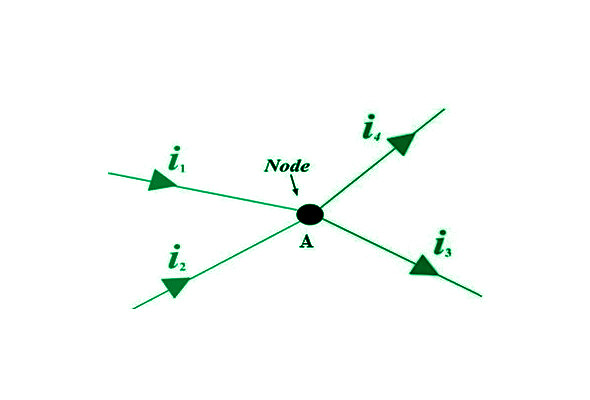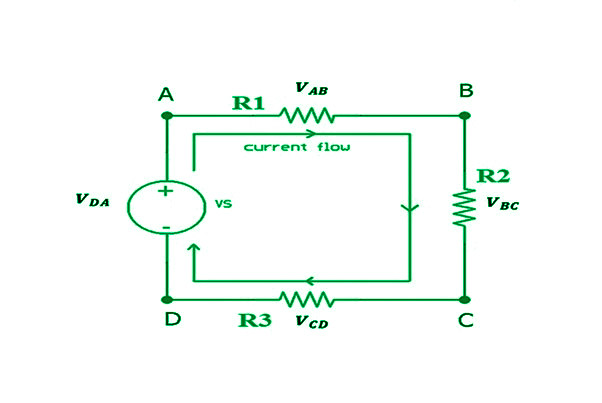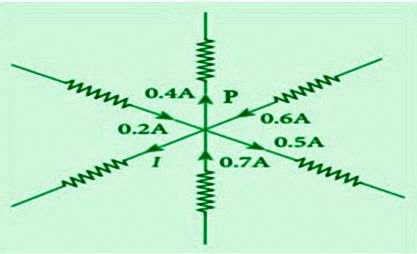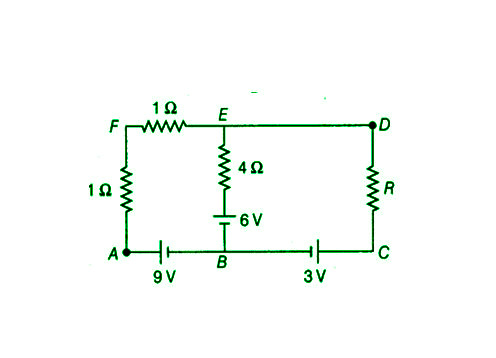基尔霍夫电路定律
穿过电通道或区域的带电粒子(例如电子或粒子)的冲击称为电流。它被计算为穿过表面或进入控制体积的电荷流的净速度。电荷传输器是移动的粒子,根据发射器的不同,它们可能是几种类型的粒子之一。在导线上传播的电子通常用作电路中的电荷传输体。
它们可以是半导体中的电子或开口。电解质中的电荷载流子是粒子,而它们是等离子体中的粒子和电子,即电离气体。安培或安培是电流的国际单位制单位,其定义为电荷以每秒一库仑的速率通过表面。安培是标准的 SI 测量单位。电流表用于计算流过电路的电量。发动机、发电机、电感器和变压器都使用由电通量产生的有吸引力的场。它们在传统导体中产生焦耳变暖,从而产生发光的光。电磁波是由随时间变化的通量产生的,用于媒体通信以传输数据。
基尔霍夫定律
古斯塔夫·罗伯特·基尔霍夫(Gustav Robert Kirchhoff)是俄罗斯出生的德国物理学家。他的工作是研究电传导。基尔霍夫电压定律 (KVL) 和基尔霍夫电流定律 (KCL) 于 1845 年出版。 (KCL)。基尔霍夫电路定律是它们结合的结果。使用这些定律进行电路分析。它们有助于计算网络中各种流中的电流。
- 基尔霍夫第一定律:该定律说“进入结或节点的总电流或电荷与离开节点的总电流或电荷完全相同,因为在节点处没有电荷损失。”换句话说,进入和离开节点的所有电流的代数总和必须为零。它也被称为基尔霍夫电流定律 (KCL)。
Note: Kirchhoff’s current law is in favour of charge conservation. As a result, a Nord or junction is a point in a circuit that does not serve as a charge source or sink.
Therefore,
n∑k=1 IK = 0
Where n denotes the total number of branches at the node with currents flowing toward or away from it.
i.e.
I(exiting)+I(entering) = 0
例如,
从电阻网络,集中在节点 A。这个节点与四个分支有关。存在两个输入电流i 1和i 2以及两个输出电流i 3和i 4 。根据基尔霍夫电流定律,节点 A 的总输入和输出电流之和现在将为零。

考虑进入节点的两个电流 i 1和 i 2为正,离开节点的两个电流 i 3和 i 4为负。
i1+i2–i3–i4=0
- 基尔霍夫第二定律:回路周围的电压降等于任何闭合网络的同一回路中连接的每个电气元件的电压降的代数总和,也等于零,也称为基尔霍夫电压定律 (KVL)。
Notes: Kirchhoff’s Voltage Rule is based on the law of conservation of energy. Because the net change in the energy of a charge after it completes a closed route must be zero.
例如,
考虑具有内部闭环的电阻网络的一部分,如图所示。在闭环中,我们希望写电压下降。根据基尔霍夫电压定律,连接在环路 ABCDA 中的组件之间的所有电压降总和为零。

所以,
n ∑ k=1 V k =0
回路中电气元件的总数由 n 给出。
IE
V AB +V BC +V CD +V DA =0
Applying Kirchhoff’s Laws
When using KCL, the currents exiting a junction must be considered negative, while the currents entering the junction must be considered positive.
Also, while using KVL, we keep the same anti-clockwise or clockwise orientation from the beginning of the loop and account for all voltage decreases as negative and increases as positive. This brings us back to the initial point when the total voltage loss is zero.
Sign conventions:
- In a loop, a rise in potential difference or EMF from lower to higher is always seen as positive.
- In a loop, a reduction in potential difference or EMF from higher to lower is always seen as negative.
- If the looping direction is the same as the current flowing through the circuit, the voltage drop across the resistor is considered negative.
基尔霍夫定律的用途
- 它用于找出在复杂电路的各个区域中流动了多少电流以及降低了多少电压。
- 它有助于确定各种电路回路中的电流方向。
- 基尔霍夫定律可以帮助您理解能量如何通过电路移动。
基尔霍夫定律的局限性
- 基尔霍夫定律有一个基本缺陷:它意味着整个环路区域没有变化的磁场,这可能会引起磁通量的变化并在电路中产生 EMF。这可能会导致高频交流电路的计算错误。
- 基尔霍夫也忽略了其他电路元件产生的电场的影响。
- KCL 的工作前提是电流仅通过导体和电线。而在高频电路中,寄生电容不能再被忽视。由于在某些情况下导体或电线充当传输线,因此电流可能会开始在开路中流动。
示例问题
问题1:连接和循环的规则是什么?
回答:
The junction rule, also known as Kirchhoff’s Current Law (KCL), states that at any given junction, the sum of the entering currents equals the sum of the outgoing currents.
Kirchhoff’s Loop Rule, often known as Kirchhoff’s Voltage Law, states that the sum of the voltage differences around the loop must equal zero (KVL).
问题2:节点电压的定义是什么?
回答:
We’re referring about the difference in potential between two nodes in a circuit when we say node voltage. One of the nodes in the circuit is chosen as a reference node. The voltages of all other nodes are measured in respect to this single reference node.
问题3:从下图中的电路中找出I的值。

回答:
Apply Kirchhoff’s first law to the point P in the supplied circuit.
Consider the sign convention: positive arrows point toward P, whereas negative arrows point away from P.
As a result, we now have the following:
0.2 A – 0.4 A + 0.6 A – 0.5 A + 0.7 A – I = 0
1.5 A – 0.9 A – I = 0
0.6 A – I = 0
I = 0.6A
问题4:基尔霍夫定律有什么意义?
回答
Kirchhoff’s principles can be used to calculate the values of unknown circuit variables like current and voltage. These principles may be applied to any circuit and can be used to identify unknown values in intricate circuits and networks (with certain limits). It assists in the comprehension of energy transfer in various circuit components.
问题 5:利用基尔霍夫原理求下电路中未知电阻 R 的值,确保没有电流流过 4 欧姆电阻。找出点 A 和 D 之间的可能差异。

回答:
Because there is no current passing through the 4 resistor , all current going along FE will travel through ED (per Kirchhoff’s first law).
Now, in mesh AFEBA, using Kirchhoff’s second law,
We have:- –1 × I – 1 × I – 4 × 0 – 6 + 9 = 0
–2I + 3 = 0
I = 3/2 A –(1)
Using Kirchhoff’s 2nd rule in mesh AFDCA once again,
We have: –1×I–1×I–I×R–3+9=0
–2I–IR+6=0
2I+IR=6 –(2)
From equations (1) and (2), we get
(2×3/2)+3/2xR=6
R=2Ω
For probable variations between A and D, as well as AFD,
We have:- VA – 3/2×1 – 3/2×1=VD
VA–VD=3V
问题 6:为什么基尔霍夫定律在高频下失效?
回答:
Because the rules KCL and KVL are incompatible with high-frequency AC circuits, Kirchhoff’s laws fail at high frequencies. At higher frequencies, the interference of induced emf caused by changing magnetic fields becomes more severe.